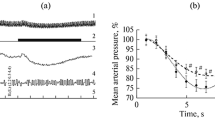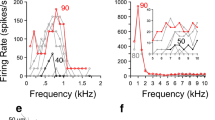Summary
In unrestrained, unanaesthetized cats a mass discharge can be recorded from the medial longitudinal fasciculus at mesencephalic level on single shock stimulation of the VIIIth cranial nerve. Latency measurements indicate that the potential is due to monosynaptic excitation of second order vestibular neurones. The changes in amplitude of this response have been investigated during physiological sleep and wakefulness. In particular the monosynaptic response is not affected during quiet wakefulness and synchronized sleep, nor during desynchronized sleep in the absence of ocular movements. A depression of the orthodromic potential, however, occurs during the transient orienting reaction elicited by arousing stimulations, and also during desynchronized sleep at the time of the rapid eye movements. The nature of this depression is discussed.
Similar content being viewed by others
References
Bizzi, E.: Changes in the orthodromic and antidromic response of optic tract during the eye movements of sleep. J. Neurophysiol.24, 861–870 (1966).
——, andI. Somogyi: Vestibular nuclei: activity of single neurons during natural sleep and wakefulness. Science145, 414–415 (1964).
—— —— —— Spontaneous activity of single vestibular neurons of unrestrained cats during sleep and wakefulness. Arch. ital. Biol.102, 308–330 (1964).
Brodal, A., O. Pompeiano, andF. Walberg: The vestibular nuclei and their connections. Anatomy and functional correlations. VIII—193 pp. Edinburgh: Oliver and Boyd 1962.
Carli, G., K. Diete-Spiff, andO. Pompeiano: Transmission of sensory information through the lemniscal pathway during sleep. Arch. ital. Biol.105, 31–51 (1967).
—— —— —— Presynaptic and postsynaptic inhibition on transmission of somatic afferent volleys through the cuneate nucleus during sleep. Arch. ital. Biol.105, 52–82 (1967).
——, andO. Pompeiano: Transmission of somatic sensory volleys through ascending spinal hindlimb pathways during sleep and wakefulness. Pflügers Arch. ges. Physiol.298, 163–169 (1967).
Gassel, M. M., P. L. Marchiafava, andO. Pompeiano: Tonic and phasic inhibition of spinal reflexes during deep, desynchronized sleep in unrestrained cats. Arch. ital. Biol.102, 471–499 (1964).
Morrison, A. R., andO. Pompeiano: Central depolarization of group Ia afferent fibers during desynchronized sleep. Arch. ital. Biol.103, 517–537 (1965).
Moruzzi, G.: The historical development of the deafferentation hypothesis of sleep. Proc. Amer. phil. Soc.108, 19–28 (1964).
Pompeiano, O.: Muscular afferents and motor control during sleep, pp. 415 to 436. InR. Granit (Ed.): Nobel Symposium I. Muscular afferents and motor control. Stockholm: Almqvist and Wiksell 1966.
—— The neurophysiological mechanisms of the postural and motor events during desynchronized sleep. InKety, S. S., E. V. Evarts andH. L. Williams (Eds.): Sleep and altered states of consciousness. Res. Publ. Ass. nerv. ment. Dis.45, 351–423 (1967).
-- Sensory inhibition during motor activity in sleep. InM. D. Yahr andD. P. Purpura (Eds.): Neurophysiological basis of normal and abnormal motor activities. Hewlett, N. Y.: Raven Press (in press).
——, andA. R. Morrison: Vestibular influences during sleep. I. Abolition of the rapid eye movements during desynchronized sleep following vestibular lesions. Arch. ital. Biol.103, 569–595 (1965).
Author information
Authors and Affiliations
Additional information
This investigation was supported by PHS research grant NB 05695-03 from the National Institute of Neurological Diseases and Blindness, N.I.H., Public Health Service, U.S.A.
Fellow of IBRO/Unesco.
Rights and permissions
About this article
Cite this article
Lenzi, G.L., Pompeiano, O. & Satoh, T. Input-output relation of the vestibular system during sleep and wakefulness. Pflugers Arch. 299, 326–333 (1968). https://doi.org/10.1007/BF00602908
Received:
Issue Date:
DOI: https://doi.org/10.1007/BF00602908




